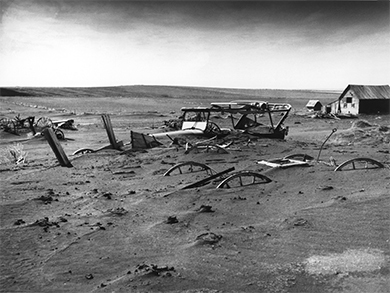| << Chapter < Page | Chapter >> Page > |
Not all farmers tried to keep their land. Many, especially those who had arrived only recently, in an attempt to capitalize on the earlier prosperity, simply walked away ( [link] ). In hard-hit Oklahoma, thousands of farmers packed up what they could and walked or drove away from the land they thought would be their future. They, along with other displaced farmers from throughout the Great Plains, became known as Okies . Okies were an emblem of the failure of the American breadbasket to deliver on its promise, and their story was made famous in John Steinbeck’s novel, The Grapes of Wrath .

Experience the Interactive Dust Bowl to see how decisions compounded to create peoples’ destiny. Click through to see what choices you would make and where that would take you.
Now we are facing a fourth year of failure. There can be no wheat for us in 1935 in spite of all our careful and expensive work in preparing ground, sowing and re-sowing our allocated acreage. Native grass pastures are permanently damaged, in many cases hopelessly ruined, smothered under by drifted sand. Fences are buried under banks of thistles and hard packed earth or undermined by the eroding action of the wind and lying flat on the ground. Less traveled roads are impassable, covered deep under by sand or the finer silt-like loam. Orchards, groves and hedge-rows cultivated for many years with patient care are dead or dying . . . Impossible it seems not to grieve that the work of hands should prove so perishable. —Caroline Henderson, Shelton, Oklahoma, 1935
Much like other farm families whose livelihoods were destroyed by the Dust Bowl, Caroline Henderson describes a level of hardship that many Americans living in Depression-ravaged cities could never understand. Despite their hard work, millions of Americans were losing both their produce and their homes, sometimes in as little as forty-eight hours, to environmental catastrophes. Lacking any other explanation, many began to question what they had done to incur God’s wrath. Note in particular Henderson’s references to “dead,” “dying,” and “perishable,” and contrast those terms with her depiction of the “careful and expensive work” undertaken by their own hands. Many simply could not understand how such a catastrophe could have occurred.
In the decades before the Great Depression, and particularly in the 1920s, American culture largely reflected the values of individualism, self-reliance, and material success through competition. Novels like F. Scott Fitzgerald’s The Great Gatsby and Sinclair Lewis’s Babbit portrayed wealth and the self-made man in America, albeit in a critical fashion. In film, many silent movies, such as Charlie Chaplin’s The Gold Rush , depicted the rags-to-riches fable that Americans so loved. With the shift in U.S. fortunes, however, came a shift in values, and with it, a new cultural reflection. The arts revealed a new emphasis on the welfare of the whole and the importance of community in preserving family life. While box office sales briefly declined at the beginning of the Depression, they quickly rebounded. Movies offered a way for Americans to think of better times, and people were willing to pay twenty-five cents for a chance to escape, at least for a few hours.

Notification Switch
Would you like to follow the 'U.s. history' conversation and receive update notifications?